ANNISTON, ALABAMA - Inspired by 1950s Soviet rifle world champion Anatoli Bogdanov, and with virtually no money for proper shooting equipment or ammunition, Gary Anderson set his sights on the highest goal in shooting as a teenager - to be the world's best.
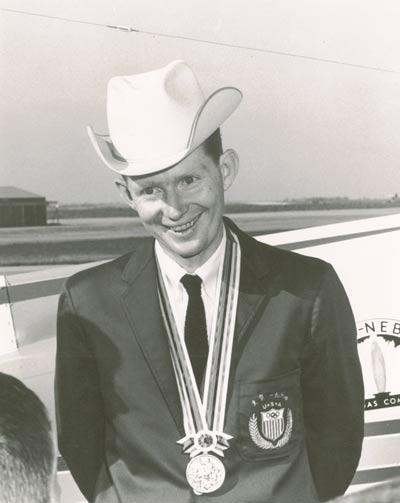
|
|
Gary after earning a Gold Medal in Tokyo.
|
He earned two Olympic gold medals, seven world championships, six world records and 16 national championships. No other American has won more Olympic and world championship three-position rifle titles.
Anderson eventually transitioned from world champion to mentor - authoring, instructing and leading thousands of US shooters, young and old, civilian and military alike down a path of marksmanship, firearms safety and sportsmanship. It's a never-ending path he says and the past 10 years at CMP has been a rewarding chapter in a career that remains open-ended.
While the face of marksmanship and firearms safety at the Civilian Marksmanship Program has changed from a single leader to an empowered team of CMP staffers, one thing is certain - Anderson's legacy and impact on CMP programs will remain forever indelible.
The soft-spoken Nebraskan, with the help of a creative staff, grew a fledgling national civilian marksmanship and firearms safety program into the premier organization of its kind today. The CMP's programs have touched hundreds of coaches and thousands of shooters across the US.
Anderson, who was appointed Director of Civilian Marksmanship in 1999, announced his retirement in December. He was honored here on 28 March at a Tribute Dinner one day after the close of the 2010 National Junior ROTC Air Rifle Championship - a program he fostered eight years earlier.
The dinner, presided over by CMP Board Vice Chair Judy Legerski, was attended by friends, family, CMP Directors, staffers and dozens of Anderson's extended family - military and civilian coaches of youth marksmanship programs from across the country. Several others who could not attend the dinner sent cards and letters to Anderson, which were displayed in an album.
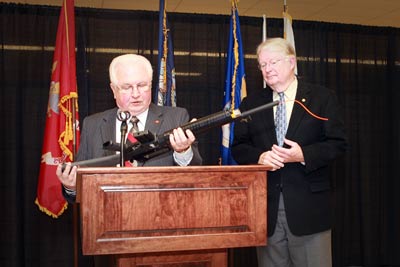
|
|
Mr. Charles Maddox, CMP Board Chairman, presented Mr. Gary Anderson with the NM AiR-15 Rifle bearing Serial Number 1.
|
In appreciation of Anderson's service, CMP Board Chairman and Chief Executive Officer Charles Maddox presented him with a Creedmoor Sports/Anschutz-built National Match Air Rifle, bearing serial number 1.
Maddox explained to the audience that Anderson inspired the development of the new competition rifle - an air-powered pellet-firing twin of the popular AR15/M16 highpower rifle. Creedmoor Sports markets the rifle commercially as the Gary Anderson Signature Model in his honor.

|
|
CMP North General Manager Christie Sewell presented Anderson with a National Match M1 Garand Rifle as a token of the staff's appreciation for his role as mentor, leader and partner in guiding the organization's marksmanship and safety programs for a decade.
|
Later in the evening, Anderson explained how much he appreciated the NM Garand because as a young Corporal in the US Army in the early 1960s, he couldn't afford the $102 cost to purchase the National Match M1 that was issued to him for firing in the National Matches.
Col. James Vanderbleek, Army JROTC Director, presented Anderson a specially engraved Daisy Model 887 sporter air rifle in appreciation of his development of the National JROTC Air Rifle Program.
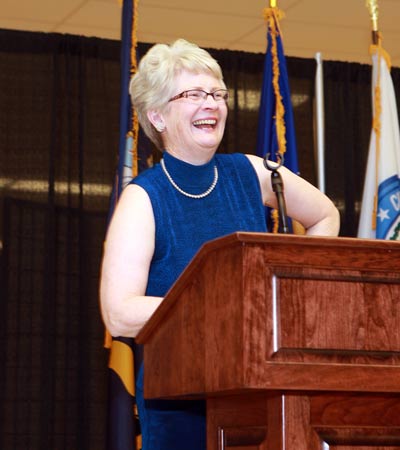
|
|
Anderson's wife Ruth Ann served as the evening's guest speaker and shared several personal memories and anecdotes from their lives beginning at Hastings College in 1962 through nearly 45 years of marriage.
|
"I gave him three rules upon his retirement. You won't be organizing my spices, you won't be grocery shopping with me and you will be making your own lunch." she joked.
Mrs. Anderson reflected on his devotion to family, shooting sports, theology, bird watching, photography and world culture. She had fond memories of hosting the first-ever summer rifle camp at their home in Axtell, Nebraska in 1970.
She shared a tender moment in 1964 when Anderson was given a parade through Hastings celebrating his first Olympic gold medal awarded in Tokyo - the first ever won by a Nebraskan in any sport.
"He stopped the parade and got out of the convertible to greet my grandmother who was sitting in a wheelchair along the road. They exchanged a really big hug," she recalled, emotionally.
Mrs. Anderson discussed the many exciting events in their lives including Anderson's presentation of the first Distinguished International Shooter Badge by President John F. Kennedy in the Oval Office in 1963, a second gold medal in Mexico City in 1968, his Masters of Divinity degree, his term as a Nebraska State Senator, his appearance on the television show To Tell The Truth and their many travels abroad.
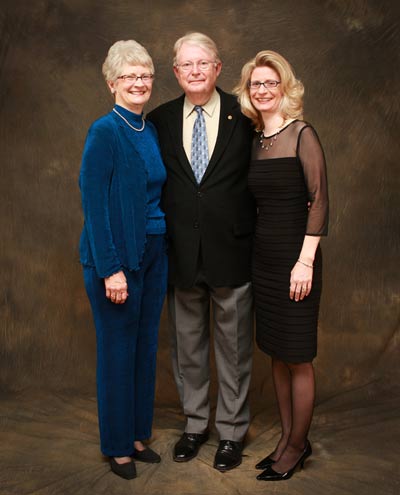
|
|
Gary and Ruth Ann with their daughter, Kirsten.
|
"We have a wonderful life. We have raised extraordinary children. We have the brightest and most adorable grandchildren," she said.
"Gary is a multi-tasker, he does not waste time - ever. He does not watch movies and he does not play games. He has little tolerance for negativity or things not intuitive," she said.
The Andersons will be spending more time with family and they are interested in supporting the creation of a Shooting Sports Museum. Future travel plans include more tours of Germany - a favorite destination, she added.
"We have an abundance of friends from all over the world. We have had phenomenal travel experiences and we enjoy good health," she said. "God has richly blessed us."
Anderson gave closing remarks about his upbringing, shooting career and his interests in furthering the development of shooting sports at home and abroad.
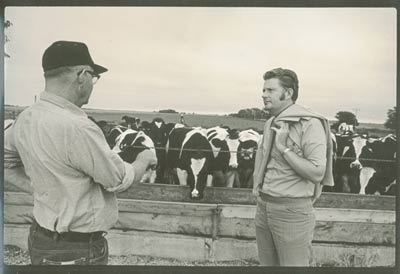
|
|
Gary talking to his Dad on the Farm in Nebraska.
|
With the help of his father, who taught him to hunt birds and small game on their farm, Anderson sponged up every bit of shooting knowledge he could absorb and melded it with countless hours of self-driven practice.
Growing up in Nebraska with no shooting aids, no coaches and very little ammunition, his drive to become a world-class marksman overcame all of those obstacles.
Since the USSR was dominating shooting sports in international competition in the 1950s, he modeled his training after Russian champ Anatoli Ivanovich Bogdanov, who credited dry-firing as one of the most important parts of rifle training.
"The dream of becoming as good as Bogdanov inspired me," Anderson said, in spite of rising political tensions between the US and Soviet Union during the Cold War.
Anderson said Bogdanov was "the greatest shooter in the world," whose accomplishments included Olympic gold medals in three-position, 300 meter free rifle in Helsinki, Finland in 1952 and the 50 meter smallbore free rifle in Melbourne, Australia in 1956.
"The importance of dry-firing resonated very well with me because I didn't have the money to buy bullets," Anderson said. "I improvised and went to work and things began to come together for me.”
"I came to the conclusion though, that the only real way I could realize my dreams was to get to the Army Marksmanship Unit," he explained.
He said he solicited a tryout with the AMU, penning a letter and submitting sample scores to then Col. Thomas Sharpe, the head of, and considered by many, the founder of USAMU. Though many speculated that Anderson's scores couldn't be trusted, Col. Sharpe "for some, yet unknown reason" granted Anderson a 90-day trial, he said.
After 30 days of dry-firing, he was allowed to fire a 40-shot standing match and his score, the second best in the unit that day, sealed his AMU assignment.
Anderson then posed a few hypothetical questions to the gathering:
"What if I had been a member of a regular shooting club, with a regular coach or instructor where my model would have been the best shooter in the club? What would have happened to Gary Anderson?”
"How would shooting history been different if Col. Tom Sharpe had decided that this kid was lying and hadn't given me a tryout with the unit? History sometimes depends on those kinds of decisions."
He answered his final question by describing what it was like to make the transition from a competition shooter to a career of devoting his efforts to serving shooters and the sport of shooting, like he had for the last 10 years at CMP.
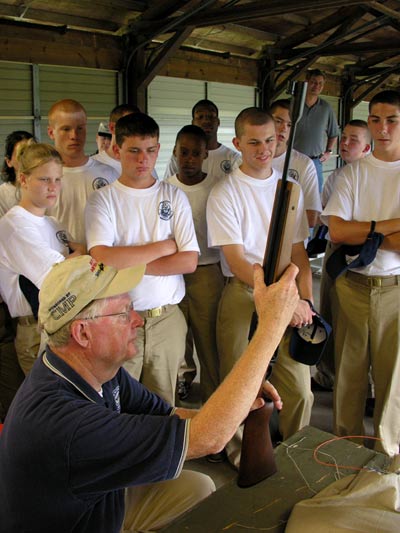
|
|
Gary teaching a clinic during a Navy JROTC Air Rifle Camp.
|
"To be a champion, your egos have to be totally focused on 'Me.' To be a teacher, a sports administrator, a coach - to be a leader, your ego has to be totally focused on 'You.' "
Anderson said he has "very vivid memories of being blown off by many experienced shooters who told me to figure it out for myself" when he was a young competition shooter on the Army International Shooting Team.
"The culture then was not one of sharing information with new shooters," he said.
But he credited three mentors who made a huge impact on his ability to transition when the time came - International Rifle Coach Bill Krilling, 1964 Olympic 300 meter bronze medalist Martin Gunnarrson and world champion pistol shooter Bill Blankenship - all of whom answered his questions and made a very deep impression on him.
"I swore to myself that if I ever did make it to the top, I would do my best to share what I had learned." He also said it always gratifies him to see young people reach their goals in shooting - he said it's as rewarding as all the medals he's won in competition.
In the end, Anderson thanked his wife, the CMP Board, its staff and the shooting sports community for making his career at CMP at success.
"No one ever does anything great alone. Our quest at CMP has always been one of "we" not "me," he added.
The reality is "retirement" is a word that can't be found in Anderson's lexicon - at least not one that applies to him. He hit the marksmanship accelerator as a youngster growing up on a farm in Axtell and hasn't let off - and he shows no signs of doing so anytime soon.
"Retirement is a negative concept to me. There's still a lot of work to be done in shooting sports and I will do my share," he said.
Today Anderson serves a DCM Emeritus where he will provide occasional instruction and consulting. He will remain busy in the US and abroad as Vice President of the International Shooting Sports Federation (the first American to serve in that capacity) and as President of the Board of USA Shooting.
NEXT ARTICLE
|


